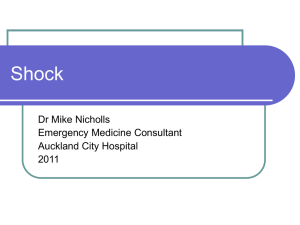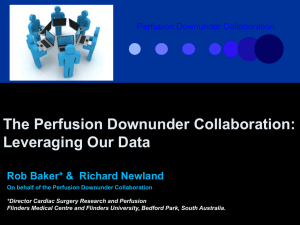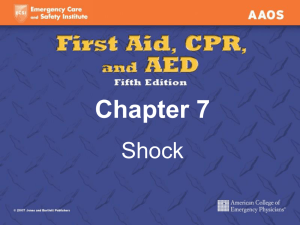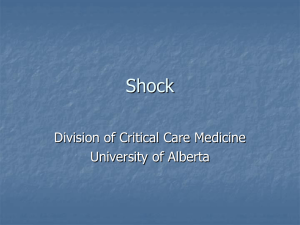summary
advertisement
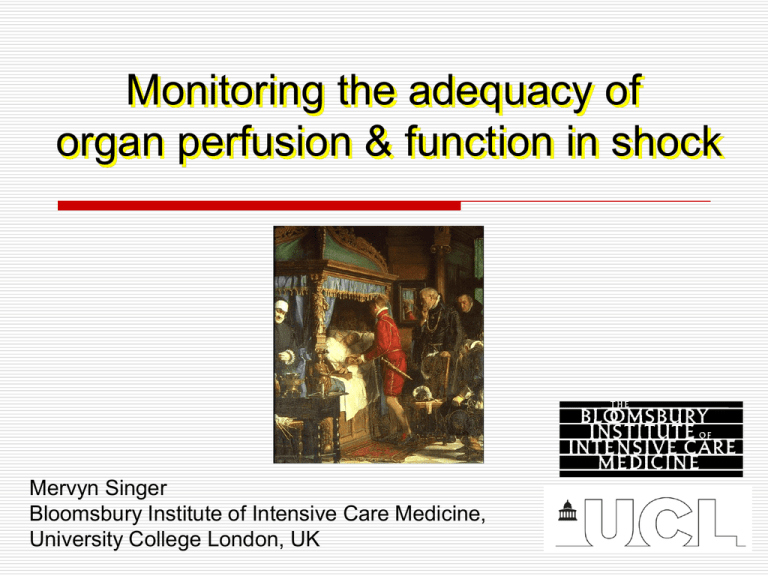
Monitoring the adequacy of organ perfusion & function in shock Mervyn Singer Bloomsbury Institute of Intensive Care Medicine, University College London, UK Declarations of potential conflicts .. (Deltex) (Edwards) Oxford Optronix - free probes Shock Delivery to, or utilisation of, oxygen that is inadequate to meet the cells’ metabolic needs Shock - a physiological definition o hypoxic hypoxia (low PO2) DO2 o circulatory hypoxia (low CO) o anaemic hypoxia (low Hb) o cytotoxic dysoxia (mitochondrial dysfunction) VO2 ‘Perfusion’ vs ‘Adequacy of perfusion’ Perfusion = oxygen delivery • flow (macro- & microcirculation) • Hb • SO2 (local PO2) Adequacy of perfusion = perfusion enough to supply tissues adequately Perfusion/Adequacy of perfusion o biochemical o lactate o base deficit o vascular and tissue respiratory gases o CO2 - tissue tension o O2 - venous, tissue, microvascular - tissue tension, saturation, VO2 o microcirculation o mitochondrial redox status Lactate o [lactate] predictive of poor outcome in …sepsis, trauma, haemorrhage o very non-specific marker of tissue hypoxia o more due to metabolic effects of epinephrine …than reduced tissue perfusion o related to ∆ muscle Na+/K+-ATPase activity …driven by epinephrine-stim’d aerobic glycolysis o high [lactate] & [epinephrine] can persist for …weeks in burn-injured patients Hyperlactataemia o .. blocked by ouabain or ß-blocker o iatrogenic causes o lactate-buffered haemofiltration o epinephrine o drugs e.g. NRTIs o non-shock causes o severe liver dysfunction o ∆ muscle protein degradation Arterial base deficit = amount of base (mmol) required to titrate 1 litre of whole blood to a normal pH, assuming normal physiological values of PaO2, PaCO2 and temperature. Arterial base deficit o ∆ H+ ion production in shock related to … ..∆ hydrolysis of ATP o arterial base deficit predictive of poor outcome … in sepsis, trauma, haemorrhage o many non-hypoxic causes of metabolic acidosis o renal dysfunction o liver dysfunction o drug toxicity (e.g. cocaine) o bicarbonate loss (e.g. diarrhoea) o hyperchloraemia … n.b. starting value of base excess may ‘camouflage’ SUMMARY: base deficit/lactate o good early prognosticators in shock states o good early guide to therapeutic response o good sensitivity o poor specificity to shock & assessment of perfusion - many confounders (patient/iatrogenic) Tissue PCO2 o gut tonometry o sublingual capnometry Tissue PCO2 - traditional view local metabolic acidosis (acid buffered by tissue HCO3-) + H pCO2 HCO3- local respiratory acidosis pCO2 (stagnant flow) Gutierrez G. Blood flow, not hypoxia, determines intramucosal PCO2. Crit Care 2005; 9:149-50 Henderson-Hasselbalch equation HCO3pHi = 6.1 + log (0.03 x PCO2) Tissue pCO2 Tissue-arterial pCO2 gap Tissue-end-tidal pCO2 gap Gastric pHi - prognosticator Low pHi related to poor outcome • Doglio (CCM ‘91) • Maynard (JAMA ‘93) • Mythen (ICM ‘94) Low pHi related to inability to wean • Mohsenifar (Ann Intern Med ‘93) Gastric pHi-guided therapy?? pHi-guided Rx improved outcome in ICU subset • Gutierrez (Lancet ‘92) … or doesn’t • Gomersall (Crit Care Med 2000) SUMMARY: tissue PCO2 o methodological/practical issues to be resolved o marker of poor regional perfusion o relevance to other regional circulations?? o reasonable prognostic tool (as good/better than lactate/base deficit) o ability to direct therapy & improve outcome??? o much hype in the 1990s .. why so quiet now?? Oxygen o mixed/central venous O2 saturation o tissue oxygen tension & saturation o oxygen consumption Mixed/central venous O2 saturation o marker of global supply/demand balance o falls in low output states e.g. heart failure o prognosticator of outcome, failure to wean… o elevated in resuscitated sepsis o microvascular shunting?? o decreased cellular utilisation?? o mixed venous vs central venous differences o one landmark ScvO2-targetted study (Rivers) SUMMARY: mixed/central SvO2 o PA catheter use decline .. ∆ reliance on ScvO2 o Rivers’ study needs repeating - recently funded o Useful in global low output states o Limited in established sepsis (other than identification of low values) Tissue O2 tension o marker of local supply/demand balance o measurable with various technologies o optode, Clark electrode, NIRS, EPR oximetry .. o falls in low output states e.g. heart failure o elevated in resuscitated sepsis o studied separately in multiple tissue beds o gut mucosa, skeletal muscle, bladder, brain, kidney (animal) o brain, skeletal muscle, conjuctiva, subcutaneously (man) Muscle tissue pO2 in septic patients sepsis limited infection cardiogenic shock control 0 60 20 40 Tissue pO2 (mmHg) Boekstegers et al, Shock 1994;1:246-53 Bladder tissue pO2 falls in other shock states 16 Resuscitation 12 Endotoxin 8 Control 4 Haemorrhage 0 0 1 2 time (h) 3 Rosser et al. J Appl Physiol 1995; 79: 1878 Singer et al. Intensive Care Med 1996; 22: 324 Stidwill et al. Intensive Care Med 1998; 24: 1209 Tissue O2 tension o no organ-organ comparisons published o influence of inspired oxygen in shock states? o impact of volume of tissue being sampled o probe size/surface area o multi-array electrodes… PO2 (mmHg) Acute response in tissue PO2 to bolus of LPS (10 mg/kg) 80 80 70 70 60 60 50 50 40 40 Muscle PO2 (mmHg) 30 Bladder 30 20 20 40 40 Kidney Liver 30 30 20 20 † † † † † † 10 10 † 0 0 0 1 2 3 Time post-LPS (h) 0 1 2 3 Time post-LPS (h) Microvascular O2 tension/saturation o Can be relatively non-invasive o NIRS, spectrophotometry techniques … measures oxyHb (?Mb) in tissue/microvascul o porphyrin phosphorescence technique … measures microvascular PO2 o skeletal muscle StO2 parallels changes in human …whole body DO2 during trauma resuscitation SUMMARY: tissue/microvascular O2 o tissue PO2 (SO2) = useful marker of local supplydemand balance in non-septic shock or in early …unresuscitated sepsis o raised in resuscitated sepsis - marker of mitochondrial dysfunction o microvascular PO2 - may provide similar info but …comparative studies needed o no outcome-related PO2-guided studies o research tool at present until better defined in pts Whole body/regional O2 consumption o Low VO2 or poor response in VO2 to challenge (fluid/dobutamine) = poor prognosis o Whole body ≠ regional VO2 o How much VO2 is coupled or uncoupled to ATP …production in shock states? Crit Care Med 2000; 28: 2837-42 Microcirculation o mainly measured sublingually o relevance of tongue to other organ beds? … but does correlate with gastric & s/l PCO2 o prognosticator of outcome in sepsis Microcirculation o relevance to local tissue O2?? o ? reactive to decreased mitochondrial utilisation c/f hyperoxia o +tive correlation between capillary O2 extraction & degree of regional capillary stopped-flow - i.e. remaining functionally normal capillaries offload more O2 to surrounding tissue o minimal cell death seen in sepsis o need for automated semi-quantification technique o no outcome-related microcirc’n-guided studies SUMMARY: microcirculation o interesting research tool for assessing perfusion o applicability of tongue to other tissue beds? o pathophysiological questions - causative or 2°?? o relative infancy - not a routine clinical tool yet Mitochondrial function o >90% of VO2 used by mitochondria o >90% of ATP in most cells generated by ETC o ..thus mitos play a fundamental role in shock o degree of dysfunction in established septic shock relates to poor outcome o ATP not yet measurable at bedside o redox status can be used for trend-following NADH fluoroscopy & NIRS oxidised reduced NADH NAD+ Rhee P et al. Near-infrared spectroscopy: Continuous measurement of cytochrome oxidation during hemorrhagic shock. Crit Care Med 1997; 25:166-170 Cyt aa3 (%change from baseline) CO stomach liver DO2 kidney VO2 muscle Mitochondrial redox state o cannot yet be quantified in vivo o good for trend-following … … ideally from normal baseline o limited use in patient who’s already critically ill SUMMARY: mitochondrion o .. the ideal organelle to monitor the adequacy of organ perfusion o .. but, at present, no bedside mitochondrial monitor that offers more than trend following SUMMARY: overall o shock is not an homogenous condition o we still lack the perfect bedside tool to assess adequacy of organ perfusion o will there ever be one? o is measuring site representative of other organ beds? o should we use an amalgam of technologies? o tool-directed outcome studies are needed

